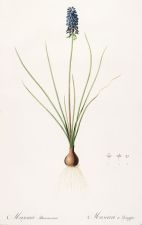Humble Grape Hyacinth
By Audrey Stallsmith

The hyacinth for constancy wi' its unchanging blue.
Robert Burns, "O Luve Will Venture In"
Gerard writes in his 1597 Herball that grape hyacinths "are kept and maintained in gardens for the pleasant smell of their floures, but not for their beauty, for that many stinking field floures do in beautie farre surpasse them."
He is speaking, however, of a yellow type which he calls "musked grape-floure"--probably Muscari moschatum. An 1876 issue of a periodical called The Country reports a little more kindly that moschatum "flowers in clusters of a dirty yellow hue and very inconspicuous, but amply atones for its shortcomings. . .by its delicious fragrance." That probably depends on whether you view musk as a delicious fragrance!
Fortunately, most grape hyacinths--then and now--bloom in much more pleasing shades of blue and purple, which contrast artistically with the warmer hues of tulips and daffodils. Although the shape of muscari's flower cluster bears some resemblance to an actual hyacinth's, its petals puff out into almost spherical shapes, and have been compared both to grapes and--with a white type--to the Pearls of Spain.
Grape hyacinths are among the earliest and toughest of spring flowers, often sending up foliage in the fall--to give themselves a head start, perhaps! They can also bloom for up to six weeks.
Muscari derives from muscus, the Latin term for musk. The most commonly grown type used to be botryoides--meaning "like a bunch of grapes." But it has given way to armeniacum which, we would guess, must have originated in Armenia. Southerners favor neglectum--also known as bluebottles or starch hyacinth--which supposedly thrives on neglect and smells like wet starch.
Actually, all of the grape hyacinths are likely to thrive. They stand for constancy for a reason! Sir William MacArthur notes somewhat apologetically in Hortus Camdenensis (1820) that they "are apt to become troublesome in a garden from their great increase."
He suggests confining them in pots instead, which is a good idea, as this raises the short flowers to a level where they can be better appreciated. You can force them indoors too, where you can view them at even closer quarters. Or you might want to try them under deciduous trees or bushes where nothing else will grow. Grape hyacinths aren't too proud to take the poor soils!
They originated in France and Italy. Their bitter, onion-like bulbs, high in saponins (soaps), are supposed to be at least mildly toxic--which probably explains why deer seldom eat them. But Italians, Greeks, and some Middle Easterners boil, sauté, or pickle those bulbs and consume them as appetizers. We will have to hope that the heating expels some of the toxins!
Muscari has also been used as a laxative, which is probably a polite way of saying that it causes diarrhea instead of constipation! It is also stimulant and diuretic (will take off excess fluid by increasing the flow of urine).
But I would suggest that you just enjoy the flowers. Doing this properly with short blooms does often mean having to get down on your stomach to view them up close. But G. K. Chesterton once said something to the effect that your world would become much larger if you could become smaller in it. Though he was speaking of humility at the time, it is actually the literal truth as well. The low viewpoint will give you a whole new perspective!
Muscari racemosum image is from Les Liliacees by P. J. Redoute, courtesy of the Missouri Botanical Garden.








